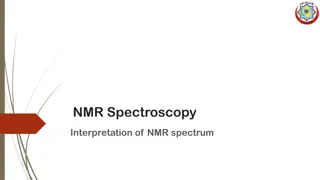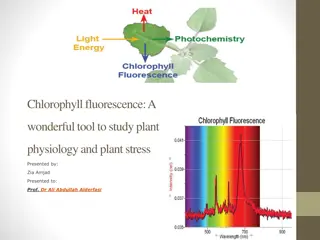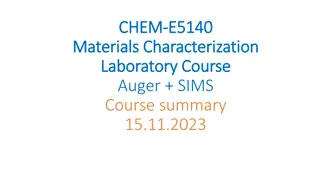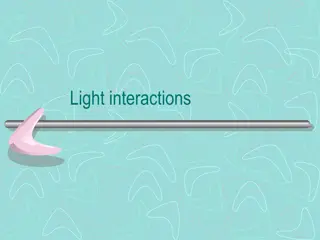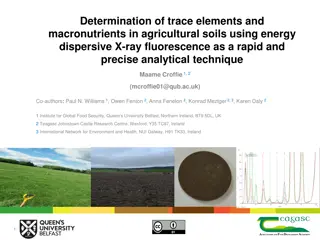Introduction to NMR Spectroscopy: A Powerful Tool for Structural Analysis
Nuclear Magnetic Resonance (NMR) spectroscopy is a vital technique in determining the structure of organic molecules. It complements IR and UV spectroscopies by providing a detailed map of the carbon-hydrogen framework. Understanding the physics behind NMR, such as nuclear spin and the effect of mag
6 views • 30 slides
Understanding NMR Spectroscopy for Structure Identification
NMR spectroscopy is a powerful tool in determining the structure of organic compounds. This summary outlines the process of using 1H NMR spectroscopy to identify an unknown compound, detailing steps such as determining different proton types, analyzing integration data, and interpreting splitting pa
3 views • 40 slides
Understanding Energy Dispersive Spectroscopy (EDS) in Microscopy
Energy Dispersive Spectroscopy (EDS) is a powerful X-ray microanalytical technique utilized in scanning and transmission electron microscopes to determine the chemical composition of samples. By analyzing the X-ray signals generated from interactions with the sample's atoms, EDS enables qualitative
8 views • 30 slides
Advanced Microscopy Techniques and Applications in Cell Biology
Explore the diverse world of advanced microscopy techniques in cell biology, from confocal and super-resolution imaging to Fluorescence Resonance Energy Transfer (FRET) microscopy and Fluorescence Recovery After Photobleaching. Discover the latest methods, considerations, and applications for studyi
3 views • 21 slides
Pascal's Rule in NMR Spectroscopy ( n+1 )
Pascal's Rule in NMR spectroscopy, also known as the (N+1) rule, is an empirical rule used to predict the multiplicity and splitting pattern of peaks in 1H and 13C NMR spectra. It states that if a nucleus is coupled to N number of equivalent nuclei, the multiplicity of the peak is N+1. The rule help
1 views • 30 slides
Elemental analysis & Structure Elucidation
Understanding elemental analysis and structure elucidation is crucial in chemistry. Learn the process, calculations, and methods involved, such as mass spectrometry, infrared spectroscopy, and nuclear magnetic spectroscopy. Discover how to determine empirical and molecular formulas using examples li
1 views • 27 slides
Understanding Molecular Vibrations and Infrared Spectroscopy in Chemistry
Molecular vibrations play a crucial role in the study of chemical compounds through infrared spectroscopy, where different modes such as stretching and bending of bonds are analyzed based on their energy levels. Infrared absorption leads to changes in dipole moments, affecting the reactivity of mole
1 views • 23 slides
Slitless Stellar Spectroscopy with the SA100 Grating Procedures
Explore the world of slitless stellar spectroscopy with the SA100 grating as detailed by Anthony Harding in the ongoing creation of the Harding Spectra Library. Learn about the equipment used, the process of determining instrument response, capture procedures, and stacking techniques for obtaining s
0 views • 30 slides
Understanding Fluorimetry: Principles and Applications
Fluorimetry is the measurement of fluorescence intensity at a specific wavelength using instruments like filter fluorimeters. It involves the excitation of molecules by radiation, causing electron promotion and emission of radiation. This process includes states like singlet and triplet, with relaxa
3 views • 45 slides
Understanding Infrared Spectroscopy and Molecular Vibrations
Exploring the fascinating world of infrared spectroscopy and molecular vibrations. Learn about the different regions of the infrared spectrum, Hooke's law, vibrational frequencies, and the types of molecular vibrations. Discover how bond strength, reduced mass, and wave numbers are interconnected in
0 views • 18 slides
Association of Renal and Cerebral Near-Infrared Spectroscopy with Adverse Outcomes in Single Ventricle Patients after Stage I Palliation
Study investigates the association between renal and cerebral near-infrared spectroscopy (NIRS) values and low cardiac output syndrome in single ventricle patients post Stage I palliation. Data from infants who underwent surgery between 2010-2019 is analyzed to determine correlations with adverse ou
1 views • 13 slides
Understanding NMR Spectroscopy of Paramagnetic Molecules
NMR spectroscopy of paramagnetic molecules is influenced by the presence of unpaired electrons, leading to broadened spectra and complex coupling mechanisms. Quadrupolar nuclei, with spins greater than 1/2, play a significant role in the relaxation and splitting of NMR signals. The interaction betwe
0 views • 19 slides
Understanding Raman Spectroscopy: Principles and Applications
Raman spectroscopy is a technique used for chemical analysis by exciting molecular vibrations with light. This inelastic scattering of light allows researchers to gather valuable information about samples. The method relies on the Raman effect, discovered by C.V. Raman, which involves the emission o
0 views • 14 slides
Understanding Fluorimetry: Principles, Applications, and Instrumentation
Fluorimetry is a technique that measures fluorescence intensity of molecules when excited by radiation. It involves the promotion of electrons from ground to excited states, leading to emission of radiation. This process includes singlet and triplet states, as well as relaxation mechanisms like Coll
0 views • 45 slides
Understanding Fluorescence Analysis in Pharmaceutical Sciences
Fluorescence analysis is a crucial technique in pharmaceutical analysis, involving the emission of radiation by molecules when excited at specific wavelengths. Factors influencing fluorescence, such as concentration, light intensity, adsorption, oxygen presence, pH, temperature, viscosity, and photo
2 views • 26 slides
Understanding Fluorescence Microscopy: Principles and Applications
Fluorescence microscopy, pioneered by British scientist Sir George G. Stokes, reveals hidden details in specimens using fluorescent dyes that emit light of longer wavelengths. This innovative technique allows for visualization of cellular components that are otherwise colorless under conventional mi
0 views • 19 slides
Understanding Zero Field Splitting in ESR Spectroscopy
Zero field splitting in ESR spectroscopy involves the relaxation times in ESR and how spin-lattice relaxation affects the spectral width. Discover how T1 value and spin lattice relaxation play a crucial role in observing sharp spectrum lines in EPR. Learn about line widths in ESR, spin dilution, and
0 views • 21 slides
Understanding UV/Visible Spectroscopy and Electromagnetic Radiation
Spectroscopy is the study of the interaction of matter with light, specifically UV and visible radiation. Electromagnetic radiation, consisting of photons, transmits energy through space as waves with oscillating electric and magnetic fields. The relationship between wavelength and frequency is key,
0 views • 50 slides
Understanding the Basics of 13C NMR Spectroscopy
Nuclear Magnetic Resonance (NMR) Spectroscopy is a powerful analytical tool used in chemistry to study the structure of molecules. This summary focuses on the application of 13C NMR spectroscopy, which provides valuable information about carbon atoms in a compound. The low natural abundance of carbo
0 views • 36 slides
Understanding Basic Concepts of Hyperspectral Imaging and Spectroscopy
Exploring the fundamental principles of hyperspectral imaging and spectroscopy, this content covers topics such as interference, diffraction, spectrometer workings using diffraction gratings, and wave properties. Lectures by Adjunct Professor Fred Sigernes delve into topics like basic spectroscopy,
0 views • 21 slides
Exploring the Fascinating World of Photophysics and Luminescence
Dive into the intriguing realm of photophysics, where various emission and loss processes lead to luminescence phenomena such as fluorescence, phosphorescence, and chemiluminescence. Discover the beauty of bioluminescence in nature, from fireflies to bioluminescent red tide events. Explore the mecha
0 views • 16 slides
NC22Plex STR Detection Kit: Advanced 5-Color Fluorescence Detection System
Explore the cutting-edge NC22Plex STR Detection Kit from Jiangsu Superbio Biomedical, offering a 5-color fluorescence detection system suitable for multiple applications. Enhance your research capabilities with this innovative product designed for precision and efficiency.
0 views • 20 slides
Structural Elucidation of Chemical Compounds Using Spectroscopy Techniques
This presentation discusses the various types of spectroscopy techniques such as UV-Visible, IR, Raman, NMR, and others used for elucidating the structure of chemical compounds. It covers the identification of molecule shapes like AB2, AB3, and AB4, with a focus on linear and non-linear structures.
0 views • 18 slides
Understanding NMR Spectroscopy and Chemical Shifts
Nuclear Magnetic Resonance (NMR) spectroscopy is a powerful technique for analyzing molecular structures based on the chemical shifts of protons. In an NMR spectrum, peaks correspond to different protons in a compound, with their positions, intensities, and spin-spin splitting providing valuable inf
0 views • 19 slides
Association of Renal and Cerebral Near Infrared Spectroscopy with Low Cardiac Output in Single Ventricle Patients
Near-infrared spectroscopy (NIRS) has been studied in infants after Stage I palliation surgery to assess its association with low cardiac output and adverse outcomes. This retrospective study investigated postoperative cerebral and renal NIRS values in infants with single ventricle physiology. Resul
0 views • 13 slides
Techniques for Hadron Spectroscopy Studies at LHCb
Hadron spectroscopy studies at LHCb focus on searching for new hadrons, measuring their properties like lineshape, lifetime, and decay modes. The LHCb detector is optimized for collecting, reconstructing, and identifying signals to improve knowledge about hadron spectroscopy. Development of data ana
0 views • 30 slides
Exploring Fluorescence Microscopy and High-Speed Cameras in Modern Biology
Delve into the fascinating world of fluorescence microscopy and high-speed cameras in biology through topics such as detectors for microscopy, Nyquist criterion, visualizing hearing in vivo, and temporal resolution insights. Learn about techniques, equipment, and practical considerations in utilizin
1 views • 69 slides
Understanding Chlorophyll Fluorescence in Plant Physiology
Chlorophyll fluorescence is a powerful tool developed in the 1990s for studying plant physiology and stress. It provides insights into photosynthetic processes at different levels, from subcellular to canopy. By measuring chlorophyll fluorescence, researchers can assess the efficiency of photosynthe
0 views • 16 slides
Advances in Baryon Spectroscopy and Hadronic Matter Studies
Discussions at the meeting focused on interpreting HADES results for e+e- and meson production in hadronic reactions, with studies involving proton, pion, light, and heavy ion beams. The role of time-like electromagnetic transitions, baryon spectroscopy, and connecting hadronic matter studies were e
0 views • 12 slides
Auger Spectroscopy: Techniques and Applications in Materials Characterization
Auger spectroscopy, named after Pierre Auger, is a powerful technique for analyzing the surface composition of materials at the atomic level. This method involves the emission of Auger electrons and characteristic x-rays upon interaction with an electron beam. It offers high surface sensitivity, ena
0 views • 29 slides
Overview of Auger Spectroscopy in Materials Characterization
Auger spectroscopy is a powerful technique used for materials characterization, involving the emission of Auger electrons to analyze the elemental composition of a sample. Named after Pierre Auger, this method provides valuable information about the surface properties of materials. The technique is
0 views • 24 slides
Optimised Live/Dead Fluorescence Spectrometry for Antimicrobial Susceptibility Testing
This study focuses on the optimisation of live/dead fluorescence spectrometry for rapid antimicrobial susceptibility testing. The research uses fluorescent dyes to distinguish between live and dead cells, providing a potential method for quick antimicrobial resistance diagnostics. The experiment inv
0 views • 16 slides
Non-Isotopic Labeling for Molecular Detection
The use of non-radioactive probes in molecular detection involves synthetic DNA or RNA molecules with specific target sequences and reporter groups detectable via fluorescence spectroscopy. Direct and indirect labeling methods utilize fluorescent dyes or enzymes conjugated to modified nucleotides, a
0 views • 20 slides
Applications and Importance of X-ray Fluorescence Spectroscopy in Analytical Chemistry
X-ray Fluorescence Spectroscopy (XRF) is a vital analytical technique used for qualitative and quantitative analysis of elements based on their X-ray emission characteristics. Dr. Uma Sharma, a Professor at Vikram University, details various X-ray analytical methods, including X-ray emission, Auger
0 views • 21 slides
Understanding Light Interactions: Reflection, Absorption, and Fluorescence
Explore the fascinating world of light interactions, where light can be reflected, absorbed, or transmitted based on the nature of the object it encounters. Learn about absorption in different materials, fluorescence, phosphorescence, and the concepts of specular and diffuse reflection.
0 views • 17 slides
Rapid Analysis of Soil Macronutrients Using Energy Dispersive X-ray Fluorescence
Determination of trace elements and macronutrients in agricultural soils is crucial for crop productivity. This study highlights the advantages, challenges, and objectives of using energy dispersive X-ray fluorescence for rapid and precise analysis. The method requires minimal sample preparation, co
0 views • 10 slides
Insights into Theoretical Approaches in NMR Spectroscopy
Theoretical approaches in NMR spectroscopy encompass diverse methods, each with varying degrees of approximation but yielding correct results within their validity. Techniques such as transition probabilities using the time-dependent perturbation theory, Zeeman interaction for energy level transitio
0 views • 32 slides
Practical Advances in Pharmaceutical Analysis Using Spectroscopy Techniques
This comprehensive guide covers various spectroscopy techniques, including UV-Vis and IR spectroscopy, as well as electrochemical analysis and flame photometry, for pharmaceutical analysis. It delves into the fundamentals of molecular spectroscopy, discussing electromagnetic radiation, quantum energ
0 views • 19 slides
Applications of Spectroscopy in Lifetimes and States Excitation
In this collection of images sourced from Johns Hopkins University's Department of Chemistry, various aspects of spectroscopy applications in determining lifetimes for electronic and vibrational excited states are highlighted. Topics covered include transition energies, dipole moments, and decay rat
0 views • 18 slides
Microscopic Techniques in Cell Biology: Lessons and Labs Overview
Explore the fascinating world of optical microscopy in cellular biology, covering topics such as image formation, contrasting techniques, fluorescence microscopy, live-imaging techniques, and quantitative microscopy. Dive into the principles behind various microscopy techniques and experimental labs
0 views • 7 slides























